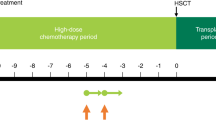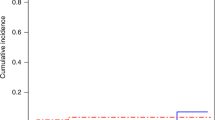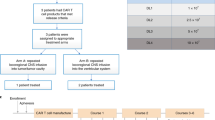Abstract
Administration of chemotherapy is often limited by myelosuppression. Expression of drug-resistance genes in hematopoietic cells has been proposed as a means to decrease the toxicity of cytotoxic agents. In this pilot study, we utilized a retroviral vector expressing methylguanine DNA methyltransferase (MGMT) to transduce hematopoietic progenitors, which were subsequently used in the setting of alkylator therapy (procarbazine, CCNU, vincristine (PCV)) for poor prognosis brain tumors. Granulocyte colony-stimulating factor (G-CSF)-mobilized peripheral blood progenitor cells were collected by apheresis and enriched for CD34+ expression. Nine subjects were infused with CD34+-enriched cells treated in a transduction procedure involving a 4-day exposure to cytokines with vector exposure on days 3 and 4. No major adverse event was related to the gene therapy procedure. Importantly, the engraftment kinetics of the treated product was similar to unmanipulated peripheral blood stem cells, suggesting that the ex vivo manipulation did not significantly reduce engrafting progenitor cell function. Gene-transduced cells were detected in all subjects. Although the level and duration was limited, patients receiving cells transduced using fibronectin ‘preloaded’ with virus supernatant appeared to show improved in vivo marking frequency. These findings demonstrate the feasibility and safety of utilizing MGMT-transduced CD34+ peripheral blood progenitor cells in the setting of chemotherapy.
This is a preview of subscription content, access via your institution
Access options
Subscribe to this journal
Receive 12 print issues and online access
$259.00 per year
only $21.58 per issue
Buy this article
- Purchase on Springer Link
- Instant access to full article PDF
Prices may be subject to local taxes which are calculated during checkout



Similar content being viewed by others
References
Chu E, DeVita VT . Principles of cancer management: chemotherapy. In: DeVita VT, Hellman S, Rosenberg SA (eds). Cancer Principles and Practice of Oncology. Lippincott Williams and Wilkins: Philadelphia, 2001, pp 289–305.
Banerjee D, Schweitzer BI, Volkenandt M, Li MX, Waltham M, Mineishi S et al. Transfection with cDNA encoding Ser 31 or Ser 34 mutant human dihydrofolate reductase into Chinese hamster ovary and mouse marrow progenitor cells confers methotrexate resistance. Gene 1994; 139: 269–274.
Hock RA, Miller AD . Retrovirus-mediated transfer and expression of drug resistance genes in human haematopoietic progenitor cells. Nature 1986; 320: 275–277.
Sorrentino BP . Gene therapy to protect haematopoietic cells from cytotoxic cancer drugs. Nat Rev Cancer 2002; 2 (6): 431–441.
Banerjee D, Bertino JR . Myeloprotection with drug-resistance genes. Lancet Oncol 2002; 3 (3): 154–158.
Hobin DA, Fairbairn LJ . Genetic chemoprotection with mutant O6-alkylguanine-DNA-alkyltransferases. Curr Gene Ther 2002; 2 (1): 1–8.
Jansen M, Sorg UR, Ragg S, Flasshove M, Seeber S, Williams DA et al. Hematoprotection and enrichment of transduced cells in vivo after gene transfer of MGMT(P140K) into hematopoietic stem cells. Cancer Gene Ther 2002; 9 (9): 737–746.
Ragg S, Xu-Welliver M, Bailey J, D'Souza M, Cooper R, Chandra S et al. Direct reversal of DNA damage by mutant methyltransferase protein protects mice against dose-intensified chemotherapy and leads to in vivo selection of hematopoietic stem cells. Cancer Res 2000; 60 (18): 5187–5195.
Allay JA, Davis BM, Gerson SL . Human alkyltransferase-transduced murine myeloid progenitors are enriched in vivo by BCNU treatment of transplanted mice. Exp Hematol 1997; 25 (10): 1069–1076.
Williams DA, Smith FO . Progress in the use of gene transfer methods to treat genetic blood diseases. Hum Gene Ther 2000; 11 (15): 2059–2066.
Kohn DB, Sadelain M, Dunbar C, Bodine D, Kiem HP, Candotti F et al. American Society of Gene Therapy (ASGT) ad hoc subcommittee on retroviral-mediated gene transfer to hematopoietic stem cells. Mol Ther: J Am Soc Gene Ther 2003; 8 (2): 180–187.
Hesdorffer C, Ayello J, Ward M, Kaubisch A, Vahdat L, Balmaceda C et al. Phase I trial of retroviral-mediated transfer of the human MDR1 gene as marrow chemoprotection in patients undergoing high-dose chemotherapy and autologous stem-cell transplantation. J Clin Oncol 1998; 16 (1): 165–172.
Moscow JA, Huang H, Carter C, Hines K, Zujewski J, Cusack G et al. Engraftment of MDR1 and NeoR gene-transduced hematopoietic cells after breast cancer chemotherapy. Blood 1999; 94 (1): 52–61.
Cowan KH, Moscow JA, Huang H, Zujewski JA, O'Shaughnessy J, Sorrentino B et al. Paclitaxel chemotherapy after autologous stem-cell transplantation and engraftment of hematopoietic cells transduced with a retrovirus containing the multidrug resistance complementary DNA (MDR1) in metastatic breast cancer patients (see comment). Clin Cancer Res 1999; 5 (7): 1619–1628.
Devereux S, Corney C, Macdonald C, Watts M, Sullivan A, Goldstone AH et al. Feasibility of multidrug resistance (MDR-1) gene transfer in patients undergoing high-dose therapy and peripheral blood stem cell transplantation for lymphoma. Gene Ther 1998; 5 (3): 403–408.
Abonour R, Williams DA, Einhorn L, Hall KM, Chen J, Coffman J et al. Efficient retrovirus-mediated transfer of the multidrug resistance 1 gene into autologous human long-term repopulating hematopoietic stem cells (see comment). Nat Med 2000; 6 (6): 652–658.
Pollok KE . In vivo protection of hematopoietic cells from alkylator-mediated DNA damage. Curr Hematol Rep 2003; 2 (4): 341–347.
Gerson SL . Clinical relevance of MGMT in the treatment of cancer. J Clin Oncol 2002; 20 (9): 2388–2399.
Jakacki RI, Siffert J, Jamison C, Velasquez L, Allen JC . Dose-intensive, time-compressed procarbazine, CCNU, vincristine (PCV) with peripheral blood stem cell support and concurrent radiation in patients with newly diagnosed high-grade gliomas. J Neuro-Oncol 1999; 44 (1): 77–83.
Maze R, Carney JP, Kelley MR, Glassner BJ, Williams DA, Samson L . Increasing DNA repair methyltransferase levels via bone marrow stem cell transduction rescues mice from the toxic effects of 1,3-bis(2-chloroethyl)-1-nitrosourea, a chemotherapeutic alkylating agent. Proc Natl Acad Sci USA 1996; 93 (1): 206–210.
Hawley RG, Lieu FH, Fong AZ, Hawley TS . Versatile retroviral vectors for potential use in gene therapy. Gene Ther 1994; 1 (2): 136–138.
Markowitz D, Goff S, Bank A . Construction and use of a safe and efficient amphotropic packaging cell line. Virology 1988; 167 (2): 400–406.
Hanenberg H, Xiao XL, Dilloo D, Hashino K, Kato I, Williams DA . Colocalization of retrovirus and target cells on specific fibronectin fragments increases genetic transduction of mammalian cells. Nat Med 1996; 2: 1–6.
Hanenberg H, Hashino K, Konishi H, Hock RA, Kato I, Williams DA . Optimization of fibronectin-assisted retroviral gene transfer into human CD34+ hematopoietic cells. Hum Gene Ther 1997; 8 (18): 2193–2206.
Relander T, Brun A, Hawley RG, Karlsson S, Richter J . Retroviral transduction of human CD34+ cells on fibronectin fragment CH-296 is inhibited by high concentrations of vector containing medium. J Gene Med 2001; 3 (3): 207–218.
Chen J, Reeves L, Sanburn N, Croop J, Williams DA, Cornetta K . Packaging cell line DNA contamination of vector supernatants: implication for laboratory and clinical research. Virology 2001; 282 (1): 186–197.
Cornetta K, Nguyen N, Morgan RA, Muenchau DD, Hartley JW, Blaese RM et al. Infection of human cells with murine amphotropic replication-competent retroviruses. Hum Gene Ther 1993; 4 (5): 579–588.
Stewart LA . Chemotherapy in adult high-grade glioma: a systematic review and meta-analysis of individual patient data from 12 randomised trials. Lancet 2002; 359 (9311): 1011–1018.
Cairncross G, MacDonald D, Ludwin S, Lee D, Cascino T, Buckner J et al. Chemotherapy of anaplastic oligodendroglioma. J Clin Oncol 1994; 12: 2013.
Wilson CA, Ng T, Miller AE . Evaluation of recommendations for replication-competent retrovirus testing associated with use of retroviral vectors. Hum Gene Ther 1997; 8: 869–874.
Kiem HP, Andrews RG, Morris J, Peterson L, Heyward S, Allen JM et al. Improved gene transfer into baboon marrow repopulating cells using recombinant human fibronectin fragment CH-296 in combination with interleukin-6, stem cell factor, FLT-3 ligand, and megakaryocyte growth and development factor. Blood 1998; 92 (6): 1878–1886.
Aiuti A, Slavin S, Aker M, Ficara F, Deola S, Mortellaro A et al. Correction of ADA-SCID by stem cell gene therapy combined with nonmyeloablative conditioning. Science 2002; 296: 2410–2413.
Williams DA, Maze R, Kurpad C, Pegg A, Erickson LC . Protection of hematopoietic cells against combined O6-benzylguanine and chloroethylnitrosourea treatment by mutant forms of O6-methylguanine DNA methyltransferase. Bone Marrow Transplant 2000; 25 (Suppl 2): S105–S109.
Gerson SL . MGMT: its role in cancer aetiology and cancer therapeutics. Nat Rev Cancer 2004; 4 (4): 296–307.
Davis BM, Reese JS, Koc ON, Lee K, Schupp JE, Gerson SL . Selection for G156A 06-methylguanine DNA methyltransferase gene transduced hematopoietic progenitors and protection from lethality in mice treated with O6-benzylguanine and 1,3-bis(2-chloroethyl)-1-nitrosourea. Cancer Res 1997; 57: 5093–5099.
Koc OM, Reese JS, Davis BM, Liu L, Majczenko KJ, Gerson SL . ΔMGMT-transduced bone marrow infusion increases tolerance to 06-benzylguanine and 1,3-bis(2-chloroethyl)-1-nitrosourea and allows intensive therapy of 1,3-bis(2-chloroethyl)-1-nitrosourea-resistant human colon cancer xenografts. Hum Gene Ther 1999; 10: 1021–1030.
Maze R, Kurpad C, Pegg AE, Erickson LC, Williams DA . Retroviral mediated expression of the P140A but not P140A/G156A mutant form of O6-methylguanine DNA methyltransferase protects hematopoietic cells against O6-benzylguanine sensitization to chloroethylnitrosourea treatment. J Pharmacol Exp Ther 1999; 290: 1467–1474.
Ragg S, Xu-Welliver M, Bailey J, D'Souza M, Cooper R, Chandra S et al. Direct reversal of DNA damage by mutant methyltransferase protein protects mice against dose-intensified chemotherapy and leads to in vivo selection of hematopoietic stem cells. Cancer Res 2000; 60: 5187–5195.
Pollok K, Hartwell J, Braber A, Cooper R, Jansen M, Ragg S et al. Effective in vivo selection of human hematopoietic cells in a xenograft model using combined pharmacologic and genetic manipulations. Hum Gene Ther 2003; 14: 1703–1714.
Acknowledgements
We thank the patients and their families for their contributions to this study. Vector was supplied by the National Gene Vector Laboratory (U42RR11148) with support from the NCRR and NCI, NIH. We thank the Indiana University General Clinical Research Center, Stem Cell Laboratory, Apheresis and BMT unit staff for excellent technical and clinical care. We thank S Harker, Jeanette Bailey, J Kellicut, Doug Heilman, and Daniel Koller for data management and statistical support; Jeff Bailey, Karen Pollok, Vickie Graves for the technical expertise. We also thank Drs Franklin Smith, Mary Dinauer, Jeffery Goldman, and Regina Jackaki for help in protocol development. This work was supported, in part, by the National Cancer Institute (PO1 CA75426) and by a Core Centers of Excellence in Molecular Hematology (CCEMH) grant (PHS P50DK49218). KC is supported in part by the Indiana Genomic Initiative (INGEN) created through a grant from the Lilly Endowment, Inc. MWK is supported through the Stop&Shop Pediatric Brain Tumor Program. We also thank Baxter/Nexell for supplying reagents for CD34+ cell selection and Amgen for supplying cytokines. Takara Bio (Otsu, Japan) has provided the gene Therapy Working Group with an unrestricted grant to help conduct clinical gene therapy trials. DAW may receive royalties based on ‘milestones’ set forth in a licensing agreement between Takara Bio and Indiana University.
Author information
Authors and Affiliations
Corresponding author
Rights and permissions
About this article
Cite this article
Cornetta, K., Croop, J., Dropcho, E. et al. A pilot study of dose-intensified procarbazine, CCNU, vincristine for poor prognosis brain tumors utilizing fibronectin-assisted, retroviral-mediated modification of CD34+ peripheral blood cells with O6-methylguanine DNA methyltransferase. Cancer Gene Ther 13, 886–895 (2006). https://doi.org/10.1038/sj.cgt.7700963
Received:
Revised:
Accepted:
Published:
Issue Date:
DOI: https://doi.org/10.1038/sj.cgt.7700963
Keywords
This article is cited by
-
In vivo selection of human embryonic stem cell-derived cells expressing methotrexate-resistant dihydrofolate reductase
Gene Therapy (2010)
-
Stem Cell Collection and Gene Transfer in Fanconi Anemia
Molecular Therapy (2007)



